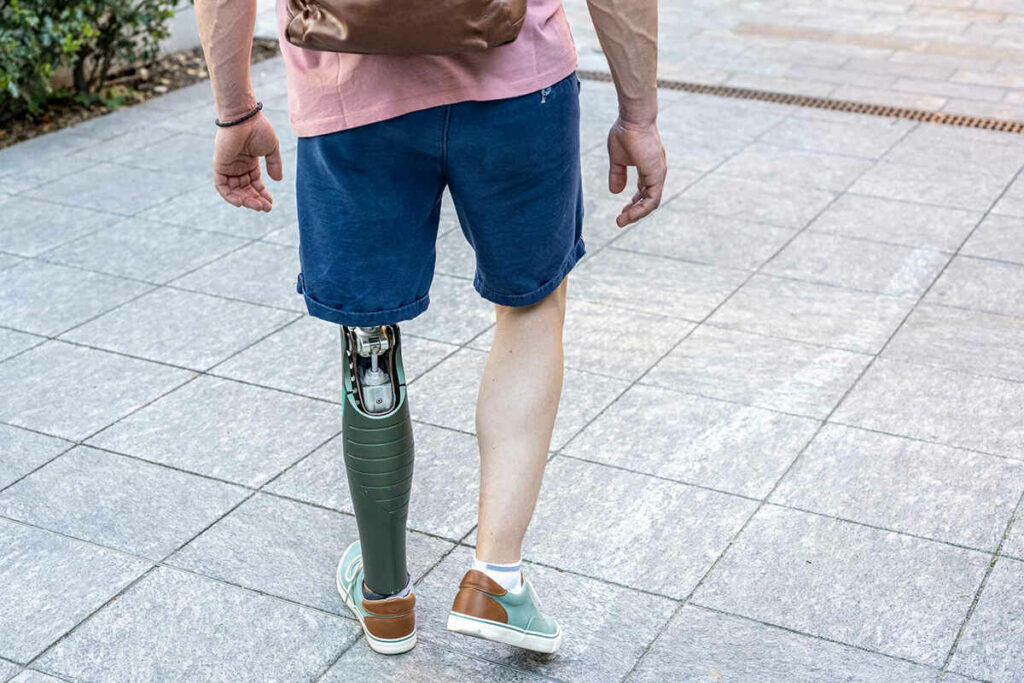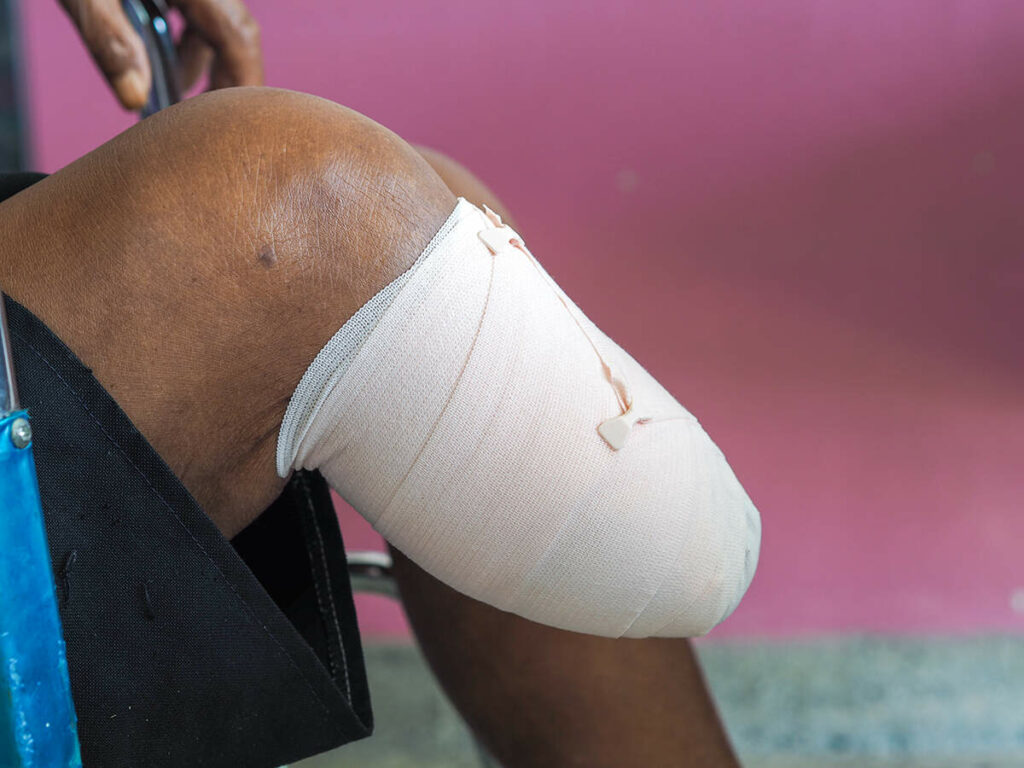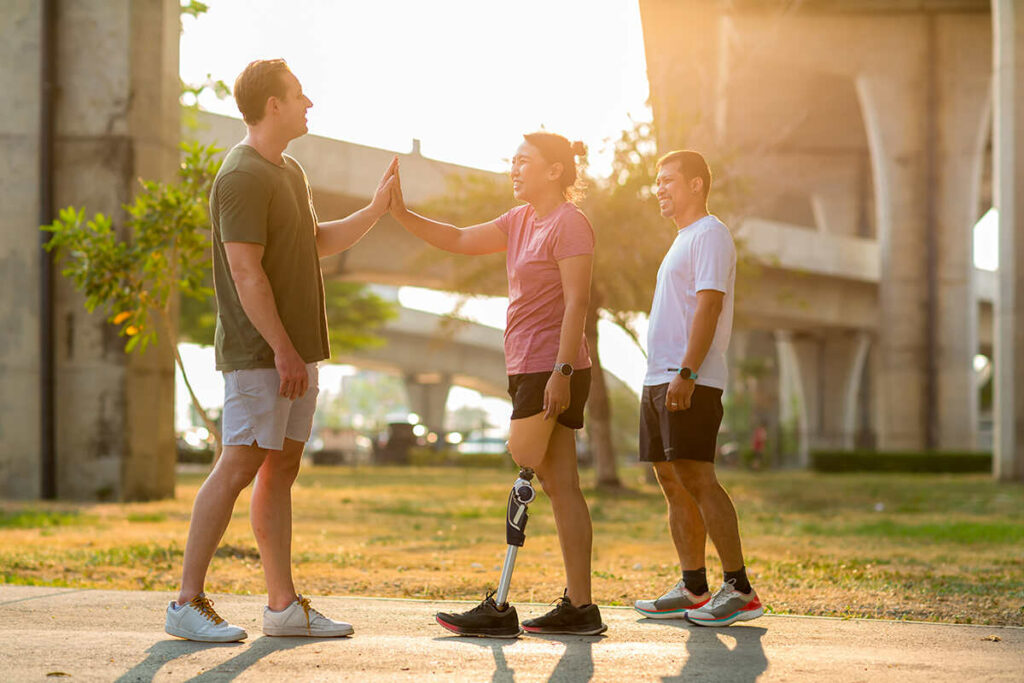Facing a leg amputation raises immediate questions about how it may affect life span. With ‘life expectancy after leg amputation’ being a primary concern, this article cuts through the uncertainty by examining the influence of factors such as existing health conditions and the type of amputation on survival rates, giving you the facts you need without excess detail.
Key Takeaways
- Life expectancy after leg amputation is influenced by a range of factors including age, gender, underlying health conditions such as diabetes and renal insufficiency, and the type of amputation performed—with below-knee amputations typically having better survival rates than above-knee amputations.
- Key components of medical management to improve outcomes post-amputation include managing peripheral arterial disease (PAD), providing thorough wound care to prevent infection, and encouraging rehabilitation through physical therapy and the use of prosthetics and assistive devices.
- Preventative strategies for reducing the risk of leg amputation focus on effective diabetes management, maintaining vascular health, and lifestyle changes such as engaging in regular exercise and smoking cessation.
Life Expectancy Factors After Leg Amputation

Life expectancy following leg amputation is influenced by a multitude of factors, with each playing a distinct role. While some factors are beyond an individual’s control, others can be managed effectively to improve outcomes. The amalgamation of these factors creates a complex picture of life post-amputation, necessitating a thorough exploration of each element.
Age and sex play a fundamental role in influencing life expectancy. The impact of these factors, however, is not as straightforward as it may seem. For instance, while older age is linked to higher mortality rates after amputation, the nuances of gender disparities in this context have not been definitively established.
The presence of underlying health conditions, such as diabetes and renal insufficiency, further complicates the picture. Diabetic patients are at a higher risk of major lower extremity amputation and face a shorter life expectancy after amputation. Similarly, individuals with kidney problems have a higher mortality risk after leg amputation, especially those undergoing hemodialysis.
Age and Sex
Delving deeper into the role of age and sex in post-amputation life expectancy, it becomes clear that these factors significantly influence survival outcomes. Notably, older age is significantly linked to higher mortality rates, especially in patients with diabetes.. This underlines the importance of rigorous healthcare management for elderly patients, particularly those with underlying health conditions.
Typical life expectancy for elderly patients with diabetes mellitus following a leg amputation varies from 1 to 5 years. These figures represent substantial mortality rates of 44% to 85% at one, three, and five-year intervals post-amputation, indicating a need for extensive healthcare management, especially for elderly patients with these conditions.
The gender disparity in survival outcomes following leg amputation remains a subject of ongoing research. Unadjusted data suggests that females may exhibit a lower survival rate than males after lower limb amputations. The reasons behind this trend, however, require further investigation.
Diabetes
A strong link exists between diabetes and leg amputation, as this condition tends to elevate the risk of lower extremity amputation and shortens life expectancy post-amputation. For example, diabetic patients forced to undergo below-knee amputations because of intractable foot problems usually have a life expectancy of less than three years.
Untreatable foot problems and diabetic foot complications are some of the factors that contribute to a decreased life expectancy after an amputation. This emphasizes the importance of effective foot care and blood sugar management in diabetic patients.
The management of blood sugar levels significantly affects the risk of leg amputation in diabetic patients. To reduce the risk of amputation, it is important to:
- Make lifestyle modifications
- Regulate blood sugar effectively
- Undergo routine foot examinations
- Maintain sustained blood sugar control
By following these steps, the majority of diabetes-related amputations can be averted.
Renal Insufficiency
Renal insufficiency refers to inadequate functioning of the kidneys, often resulting from reduced blood flow to the kidneys due to renal artery disease. Individuals with end-stage kidney failure, particularly those undergoing dialysis, have a higher likelihood of undergoing toe, foot, or leg amputation.
Renal insufficiency considerably influences the mortality risk post-leg amputation. Over 35% of initial lower extremity amputations happen in individuals with renal insufficiency, resulting in a postoperative mortality rate exceeding 50% among these individuals.
Inadequate renal function can result in a heightened mortality rate following a lower-extremity amputation, especially in individuals with kidney failure who are receiving dialysis. In such cases, the risk of mortality is four times higher in association with amputation.
Types of Leg Amputations and Their Impact on Survival
The kind of leg amputation carried out has a substantial impact on life expectancy. It’s noteworthy that below-knee amputations have a higher survival rate than above-knee amputations. This difference in recovery rates is crucial for patients who have experienced major lower extremity amputations, such as major lower limb amputation, highlighting the need for careful surgical decision-making.
The various classifications of lower limb amputation, such as above-knee and below-knee amputations, as well as toe amputation, among others. Each classification presents different challenges and potential outcomes, affecting both the immediate post-operative recovery phase and long-term survival rates.
Understanding the impact of the type of amputation on life expectancy is vital. For instance, the mortality rates following below-knee amputation range from 13 to 40% in one year, 35–65% in three years, and 39–80% in five years, which is worse than most malignancies. Diabetic foot ulcers and amputation are associated with increased mortality.
Below-Knee Amputation (BKA)
Below-Knee Amputation (BKA) exhibits a superior survival rate in comparison to Above-Knee Amputation (AKA). The survival rate at 1 year for BKA is 74.5%, and at 5 years, it is 37.8%. These figures underscore the importance of surgical decision-making in the context of leg amputation.
Numerous factors contribute to the survival rate in BKA patients, including:
- Medical comorbidities
- Surgical factors
- Rehabilitation outcomes
- Renal disease
- Advanced age
- Peripheral arterial disease (PAD)
Recognizing these risk factors allows for a comprehensive approach to care, thereby improving survival rates.
The impact of the type of amputation on life expectancy can be significant. For diabetic patients needing BKA due to untreatable foot problems, life expectancy is notably low, generally less than 3 years.
Above-Knee Amputation (AKA)
Contrarily, Above-Knee Amputation (AKA) carries a higher mortality risk compared to Below-Knee Amputation (BKA). The average five-year mortality rate for individuals who are able to walk after above-knee amputation is 30 percent. This underscores the importance of comprehensive healthcare management to improve outcomes in AKA patients.
The common factors that contribute to the higher mortality risk in AKA patients compared to BKA patients include:
- Cardiac disease
- Stroke
- Malignancy
- Renal complications
- Diabetes
Understanding these factors is crucial in devising effective strategies to manage the health of AKA patients.
Typical reasons behind above-knee amputations include:
- Complications from diabetes, such as peripheral vascular disease, open wounds, and infection
- Traumatic accidents or injuries
- Blood vessel disease
- Cancer
- Excessive bleeding
- Nerve damage
Taking preventive steps to avoid foot ankle surg-related conditions can significantly reduce the risk of needing an above-knee amputation.
Medical Management and Life Expectancy
Medical management is crucial in improving life expectancy following leg amputation. It primarily involves managing Peripheral Arterial Disease (PAD) and ensuring good wound care. These aspects enhance the immediate post-operative recovery and contribute to long-term survival.
The management of PAD, which includes lifestyle modifications and treatment, has been shown to have a substantial positive effect on the life expectancy of individuals who have undergone leg amputation. This highlights the importance of proactive PAD management in the post-amputation care plan.
Proper wound care plays a significant role in impacting life expectancy after amputation by reducing the risk of complications and promoting better wound healing. By ensuring effective wound management strategies, healthcare professionals can contribute to lower mortality rates and improved patient outcomes.
Peripheral Arterial Disease (PAD) Management
Peripheral Arterial Disease (PAD) is a critical focus area in the post-amputation care plan. The disease, characterized by the narrowing of the peripheral arteries, significantly impacts life expectancy after leg amputation.
Effective PAD management encompasses medical management and palliative care, both of which contribute to the reduction of post-amputation mortality. This necessitates a comprehensive approach that not only addresses the disease itself but also its associated complications.
The difficulties in managing PAD after leg amputation include addressing the increased risk of cardiovascular disease, coping with limitations in physical function, ensuring a good quality of life, and managing the physical and psychological impact of amputation. Overcoming these challenges requires proactive management of peripheral artery disease and vascular blockages, embracing a healthy lifestyle, providing education on proper foot care, and making suitable dietary adjustments.
Wound Care and Infection Prevention

Following a leg amputation, proper wound care is essential in preventing infection and promoting effective healing. The wound care regimen typically involves daily cleansing of the incision with soap and water, beginning approximately 72 hours after surgery.
Infection prevention strategies play a crucial role in post-amputation wound care. Regular monitoring of the wound site, frequent cleaning and dressing changes, and daily cleansing of the residual limb with a pH-balanced soap are some of the measures that healthcare professionals take to prevent infection.
Inadequate wound care can lead to a range of complications, including infection, delayed wound healing, and complexities with the residual limb. As such, the importance of proper wound care and infection prevention cannot be overstated in the post-amputation care plan.
Rehabilitation and Quality of Life After Leg Amputation
Rehabilitation is a key component in the recovery process following leg amputation. It includes physical therapy along with the use of prosthetics and assistive devices, all aimed at improving the quality of life for amputees.
The objectives of physical therapy for individuals with leg amputations encompass:
- Maintenance and enhancement of circulation
- Skin health
- Strength
- Endurance
This underscores the importance of physical therapy in the post-amputation recovery process.
Prosthetics and assistive devices exert a beneficial influence on the quality of life for leg amputees. They contribute to:
- Increased employment opportunities
- Improved quality of life
- Decreased secondary health complications
- Facilitate the natural execution of daily activities, thereby enhancing self-esteem.
Physical Therapy
Physical therapy is a crucial component of the rehabilitation process following leg amputation. It typically commences within a few days following the surgical procedure, focusing on general conditioning exercises, stretching and strengthening exercises for the arm muscles, and enhancing endurance.
The primary objectives of physical therapy following a leg amputation include assisting patients in relearning how to stand, balance, and walk. This highlights the importance of physical therapy in improving mobility and independence in amputees.
Specific physical therapy exercises recommended for individuals with leg amputations include:
- Seated push-ups
- Partial squats
- Wall squats
- Pelvic tilt exercises
These exercises are designed to strengthen the muscles and improve balance and coordination, ultimately enhancing the quality of life for amputees.
Prosthetics and Assistive Devices

The use of prosthetics and assistive devices can significantly improve the quality of life for amputees. These devices serve as functional substitutes for the original limb, facilitating day-to-day tasks and enhancing mobility.
Prosthetics are tailored to meet the specific needs of individual amputees through the process of designing and constructing each prosthetic limb to fit the unique requirements and circumstances of the patient. This ensures that each amputee receives a prosthetic device that is customized to their needs, thereby improving functionality and comfort.
The advancements in prosthetics technology over the years have significantly enhanced the functionality and comfort of these devices. Notable advancements include:
- Myoelectric sensors
- Osseointegration
- Targeted muscle reinnervation (TMR)
- Utilization of 3D printing, device implants, and digital design tools.
Case Studies: Life Expectancy After Leg Amputation
A nuanced comprehension of life expectancy post-leg amputation necessitates consideration of specific patient populations. Case studies offer valuable perspectives by examining life expectancy in diabetic and elderly patients, two groups particularly prone to leg amputation.
Diabetic individuals typically experience a decreased life expectancy after undergoing a leg amputation. This underpins the importance of comprehensive diabetes management and preventative care in these patients.
Older patients also face unique challenges after leg amputation, including a higher risk of complications and a shorter life expectancy. This emphasizes the importance of rigorous healthcare management for elderly patients, particularly those with underlying health conditions.
Diabetic Patients
Diabetic patients face a unique set of challenges following an amputation. The typical life expectancy of diabetic individuals following a leg amputation is relatively low, typically ranging from less than 3 years to 5 years. This highlights the importance of comprehensive diabetes management in these patients.
Diabetes can impact the recovery process and the complete healing of the wound may take 4 to 6 weeks, and there may be initial discomfort. This underscores the importance of effective wound care and infection prevention in diabetic patients.
The amputation of a leg can occur as a consequence of poorly managed diabetes, often stemming from decreased blood flow or peripheral neuropathy. Effective diabetes management and consistent foot care play a crucial role in preventing the development of diabetic foot ulcer and severe foot sores that may ultimately necessitate amputation.
Elderly Patients
Elderly patients represent another group that is particularly at risk of major amputation. Following major leg amputation, elderly patients have an overall mortality rate of 44% after 1 year, 66% after 3 years, and 85% after 5 years. This underscores the significance of comprehensive healthcare management in elderly patients.
Elderly patients frequently experience postoperative complications including:
- Delirium
- Falls or trauma
- Wound infection
- Tissue necrosis
- Pain subsequent to leg amputation
This highlights the importance of effective postoperative care in this population.
In order to improve the life expectancy of elderly patients after a leg amputation, specific treatment strategies encompass rehabilitation under the guidance of a physical medicine and rehabilitation physician, and prosthetic rehabilitation to facilitate the attainment of maximum patient independence.
Preventative Measures and Reducing Amputation Risk
Prevention and risk mitigation are vital in managing conditions that could result in leg amputation. Two significant areas that can considerably lessen the risk of leg amputation are efficient diabetes management and maintaining vascular health. Lifestyle modifications like blood sugar control, healthy eating, regular physical activity, and avoiding smoking are critical in managing diabetes effectively and minimizing the amputation risk associated with the condition.
The maintenance of vascular health, achieved through revascularization to re-open or bypass blocked arteries, and regular examination of legs and feet for sores or changes, can substantially decrease the risk of leg amputation.
Diabetes Management
Effective diabetes management is crucial in preventing complications that may lead to leg amputation. The essential elements of effective diabetes management comprise:
- Self-care practices
- Monitoring blood glucose levels
- Regular blood pressure checks
- Engaging in exercise
- Managing blood glucose, blood pressure, and cholesterol levels.
Elevated blood sugar levels can elevate the risk of leg amputation due to their association with complications like peripheral artery disease (PAD) and diabetic neuropathy. This underscores the importance of blood sugar management in diabetic patients.
A well-balanced diet for the management of diabetes, which includes:
- lean meats
- fruits
- vegetables
- fiber
- whole grains
is instrumental in maintaining stable blood sugar levels and can mitigate the risk of amputation. Regular exercise also contributes to the control of blood sugar levels, which plays a big part in managing diabetes and subsequently reduces the risk of leg amputation resulting from diabetes-related complications.
Vascular Health Maintenance
Maintaining good vascular health can significantly reduce the risk of peripheral arterial disease, a condition that can lead to leg amputation. The essential factors to consider in preserving optimal vascular health include maintaining a healthy weight, consuming a diet low in cholesterol and saturated fat, and engaging in regular exercise.
Smoking has been shown to:
- Increase the formation of plaque in blood vessels
- Narrow arteries
- Cause blood to thicken and form clots
- Lead to damage to the heart and blood vessels
- Ultimately result in atherosclerosis and cardiovascular disease
This emphasizes the importance of smoking cessation in maintaining vascular health, as supported by research.
Regular exercise has been shown to have impact on vascular health, including:
- Reducing cardiovascular mortality and the risk of developing cardiovascular disease
- Lowering blood pressure
- Maintaining heart health
- Promoting the growth of blood vessels
- Improving artery health
- Boosting blood circulation
- Creating more physical connections between small blood vessels.
Frequently Asked Questions
What happens if you don’t amputate a leg?
If a leg is not amputated, the lack of oxygen and nutrients can lead to tissue death, infection, and potentially life-threatening complications, such as gangrene. It is important to consider the risks and benefits of amputation in consultation with medical professionals.
What not to say to someone who lost a leg?
Avoid saying “I know how you feel” as it can diminish their own feelings. Sometimes, silence can be more comforting than words. Also, avoid saying “You’re an inspiration” or “Good for you” as some amputees may find it patronizing. Instead, offer your support in a genuine and thoughtful manner.
How does losing a leg affect you?
Losing a leg can greatly impact your mobility, independence, emotional well-being, and quality of life. It can also lead to ongoing pain, phantom limb sensations, and emotional trauma, making recovery challenging.
What do you say to someone who has had their leg amputated?
You could say, “I’m here for you and I’m so sorry for what you’re going through. If you ever want to talk or if there’s anything I can do to help, please let me know.” Being a good listener and allowing your friend to share his feelings is also helpful.
How long does it take for an amputated leg to heal?
The wound at the amputation site usually heals within 3-4 weeks, but the scar on the inside takes about 12 to 18 months to heal fully. Proper wound management is crucial during the early phase to promote healing and reduce infection risk.









